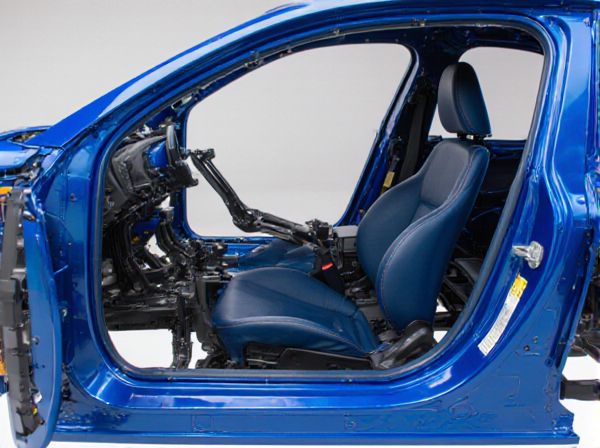
Photo illustration: Space Frame vs Backbone Frame
Space frames offer a three-dimensional structural solution composed of interconnected struts arranged in a geometric pattern, providing exceptional strength and rigidity for architectural and engineering projects. Backbone frames, on the other hand, prioritize a linear, central support system that enhances stability and flexibility primarily along a single axis. Choosing the right frame depends on your project's load requirements and spatial constraints.
Table of Comparison
| Feature | Space Frame | Backbone Frame |
|---|---|---|
| Structure | 3D tubular frame with interconnected members | Central backbone tube with attached subframes |
| Weight | Lightweight due to efficient load distribution | Heavier due to central beam and attachment points |
| Strength | High torsional rigidity and strength | Good longitudinal strength, less torsional rigidity |
| Manufacturing Complexity | Complex welding and assembly processes | Relatively simpler construction |
| Applications | Sports cars, racing cars, luxury vehicles | Off-road vehicles, trucks, some sports cars |
| Cost | Higher due to material and labor intensive | Lower manufacturing costs |
Introduction to Frame Structures in Engineering
Space frames and backbone frames represent two fundamental types of frame structures in engineering, each optimized for distinct load distribution and stability requirements. Space frames consist of interconnected struts arranged in a three-dimensional lattice, offering high strength-to-weight ratios and exceptional resistance to bending and twisting forces. Backbone frames, typically linear and supporting major structural loads along a primary axis, provide efficient load transfer but less spatial rigidity compared to space frames, making them suitable for elongated structures like bridges and towers.
Overview of Space Frame Design
Space frame design utilizes a three-dimensional truss system composed of interconnected struts arranged in a geometric pattern, offering high strength-to-weight ratios and efficient load distribution. This structural approach enhances rigidity and stability while minimizing material usage compared to traditional backbone frame designs. Space frames are commonly employed in applications requiring lightweight yet robust construction, such as aerospace, automotive chassis, and architectural structures.
Fundamentals of Backbone Frame Architecture
Backbone frame architecture centers around a single, robust longitudinal beam that supports the vehicle's main structural loads, offering enhanced rigidity and simplified load paths compared to space frame designs. This framework efficiently absorbs torsional and bending forces through its continuous backbone, improving stability and handling performance. Designed primarily for vehicles requiring a durable yet lightweight chassis, backbone frames facilitate easier manufacturing and maintenance by reducing the number of interconnected components characteristic of space frame structures.
Structural Strength and Rigidity Comparison
Space frames exhibit superior structural strength and rigidity due to their triangulated geometry distributing loads evenly across multiple members, reducing stress concentrations. Backbone frames rely on a central structural member for support, resulting in less overall rigidity and increased susceptibility to bending and torsional stresses under heavy loads. Engineering analyses consistently show space frames outperform backbone frames in load-bearing capacity and resistance to deformation.
Weight Efficiency: Space Frame vs Backbone Frame
Space frames offer superior weight efficiency by distributing loads through a network of interconnected struts, minimizing material usage while maintaining structural rigidity. Backbone frames concentrate forces along a central spine, often resulting in heavier designs due to the need for reinforced elements to handle torsional stresses. The optimized load paths in space frames lead to lighter yet strong structures compared to the typically bulkier backbone frames.
Manufacturing Complexity and Cost
Space frames, characterized by interconnected struts forming a triangulated structure, involve higher manufacturing complexity due to precise welding and assembly requirements, leading to increased labor and tooling costs. Backbone frames consist of a single central member supporting the vehicle's load, offering simpler fabrication with fewer components and reduced production expenses. Consequently, backbone frames are typically more cost-effective and easier to manufacture compared to the intricate space frame structures.
Applications in Automotive and Aerospace Industries
Space frames, characterized by interconnected struts forming a rigid, lightweight structure, are extensively utilized in high-performance automotive applications such as race cars and sports vehicles due to their superior strength-to-weight ratio and torsional rigidity. Backbone frames, featuring a central structural member with attached components, are commonly applied in motorcycles and certain aerospace ground support equipment where simplicity, ease of manufacturing, and adequate load distribution are critical. The aerospace industry increasingly favors space frame designs for lightweight aircraft fuselages and satellite structures to maximize fuel efficiency and payload capacity while ensuring structural integrity under dynamic stresses.
Flexibility and Customization Potential
Space frame architecture offers superior flexibility and customization potential compared to backbone frame structures, enabling designers to create complex, multi-dimensional frameworks that adapt easily to various load conditions and architectural designs. The interconnected strut-based design of space frames distributes weight evenly, allowing for expansive spans without internal supports, which enhances open floor plans and modular scalability. In contrast, backbone frames typically follow linear load paths with limited adaptability, making them less suitable for projects requiring extensive modifications or unique spatial configurations.
Maintenance and Longevity Considerations
Space frames offer superior durability due to their triangulated structure, which evenly distributes stress and minimizes fatigue over time. Backbone frames, while simpler and lighter, may require more frequent inspections and reinforcements to address stress concentrations, impacting long-term maintenance demands. The choice between space frame and backbone frame significantly affects repair costs and vehicle lifespan, with space frames generally providing longer-lasting structural integrity.
Choosing the Right Frame: Key Factors and Recommendations
Selecting between a space frame and backbone frame hinges on factors like weight distribution, structural rigidity, and intended use. Space frames excel in providing superior torsional stiffness and crash safety, making them ideal for high-performance and off-road vehicles. Backbone frames offer simplicity, ease of manufacturing, and are preferable for lightweight or classic cars requiring straightforward maintenance and repair.
 caratoz.com
caratoz.com